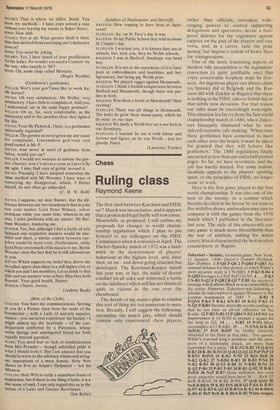Chess
Ruling class
Raymond Keene
The first clash between Korchnoi and FIDE on 7 March was inconclusive, and it appears that a protracted legal battle will now ensue. Meanwhile, as promised, I will outline my proposals for changes in world championship regulations which I plan to put forward to my colleagues on the FIDE Commission when it convenes in April. The Fischer-Spassky match of 1972 was a landmark in the deterioration of players' behaviour at the highest level, and, since then, an on and down-going situation has developed. The Korchnoi-Karpov match last year was, in fact, the nadir of decent conduct on all sides and witnessed a battle on the sidelines (which still has not finished) quite as vicious as the one over the chessboard.
The details of my master-plan to combat this sort of thing are too numerous to mention. Broadly, I will suggest the following: streamline the match jury, which should contain only experienced chess players, rather than officials; introduce wideranging powers to control supporting delegations and spectators; devise a foolproof defence for the organisers against carprice on the part of the players and vice versa, and, as a carrot, raise the prize money, but impose a system of heavy fines for transgressjons.
One of the more frustrating aspects of modern rule preparation is the legislators' conviction (a quite justifiable one) that every conceivahle loophole must be foreseen. An ingenious player can always claim (as Spassky did at Belgrade and the Russians did with Zukhar at Baguio) that there is nothing in the FIDE rules to forbid this or that subtle new deviation. For that reason our rules must be exceedingly watertight. This situation is a far cry from the first world championship match in 1886, when Zukertort brusquely dismissed what he considered excessive rule-making: 'When once these gentlemen have consented to meet . each other over the board, it must be taken for granted that they will behave like gentlemen.' The 1886 regulations finally amounted to less than ckne and a half printed pages. So far, we have seventeen, and the job has barely started. For some reason, idealistic appeals to the players' sporting spirit, or the principles of FIDE, no longer seem to work.
Here is the first game played in the first world championship. It was also one of the best of the twenty, in a contest which Steinitz decided in his favour by ten wins to five with five draws, and readers may care to compare it with the games from the 1978 match which I published in the Spectator last year. The style of this nineteenth century game is much more bloodthirsty than the war of attrition, waiting for minor errors:Which characterised the best modern counterparts at Baguio.
Zukertort — Steinitz, 1st match game, New York, 11 January, 1886. Queen's Gambit Declined, Slav Defence. 1 P-Q4 P-Q4 2 P-QB4 P-QB3 An unusual defence for that period, to which White's most accurate reply is 3 N-QB3. 3 P-K3 B-B4 4 N-Q83 Stronger is 4 PxP PxP 5 Q-N3. 4 . . . P-K3 5 N-B3 N-Q2 6 P-QR3 B-Q3 7 P-B5 An incorrect strategy which allows Black to react powerfully in the centre. However, Zukertort was following a scheme he had employed against Winawer in the London tournament of 1883. 7 . . . B-B2 8 P-QN4 P-K4 9 B-K2 KN-B3 10 B-N2 P-K5 11 N-Q2 P-KR4 Steinitz shrewdly avoids castling so that he can start an all-out offensive on the K-side. 12 P-R3 N-B1 13 P-QR4 N-N3 14 P-N5 An improvement is 14 N-N3 to prepare a square for the king at 02. 14 . . . N-R5 15 P-N3 More circumspect is 15 B-KB1. 15. . . N-N7ch 16 K-B1 NxPch: 17 PxN BxNP As Hoffer correctly observed in the Field at that time: 'Two pawns, White's exposed king's position, and the prospects of a formidable attack, are more than equivalent for a piece.' 18 K-N2 B-B2 19 Q-KN1 R-R3 20 K-B1 R-N3 21 Q-B2 Q-Q2 22 PxP PxP 23 R-KN1 BxPch 24 K-K1 N-N5 25 BxN BxB 26 N-K2 Q-K2 27 N-KB4 R-R3 28 B-B3 P-N4 29 N-K2 R-B3 30 Q-N2 R-B6 31 N-KB1 R-N1 32 K-Q2 P-B4 33 P-R5 P-B5 34 R-R1 Q-B2 35 R-K1 PxPch 36 NxP R-B7 Quite sufficient, but even more attractive would have been 36. . . RxN 37 KxR B-B5ch 38 K-B2 R-N6. 37 QxR QxQ 38 NxB B-B5ch 39 K-B2 PxN 40 B-Q2 P-K6 41 B-B1 Q-N7 42 K-B3 K-Q2 43 R-R7ch K-K3 44 R-R6ch K-B4 45 BxP BxB 46 R-Bich 8-85 White resigns.








 Previous page
Previous page